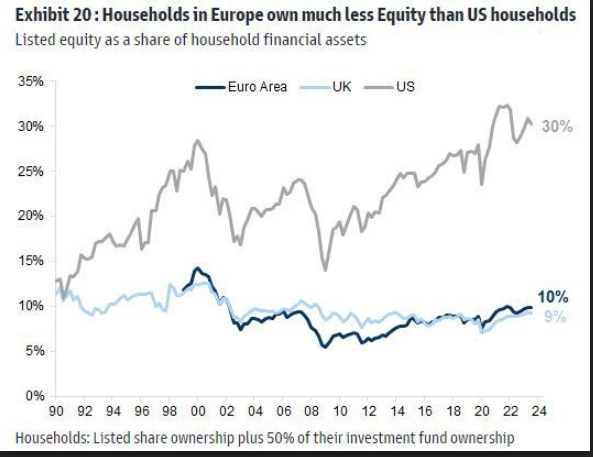This week’s ‘CPI Print’ has caused something of a panic in the bond markets and has left the ‘Pivot’ Pundits struggling versus the ‘No Cuts’ crowd, some of whom are now doubling down and even talking about rate rises. Traders in other markets are looking across with some degree of concern, long wary of the ability of the bond markets to trigger problems elsewhere. So too are the politicians, keen for their particular narrative on the economy to win them votes, but concerned that they need the markets (and by extension the Fed) to support their cause. The Treasury are obviously concerned, given the amount of supply coming through as the politicians pass ever larger Budgets, but most of all, the Fed recognise that the Fed Put is now focused on the Bond markets, which are now the main ‘risk on’ Asset to worry about, Gold being the new ‘risk off’ asset. All parties need the economy to be hot (or cold) enough but not so extreme as to trigger either the Fed or the bond markets. In effect everyone wants a slightly different form of Goldilocks, while investors are increasingly wanting Gold..
While everyone in the bond markets is watching the high frequency data to see what the Fed will do, the Fed is actually watching the bond markets.
After years of talking about the Fed ‘put’ to support equity markets, the reality is that the Fed is now much more focused on the stability of the bond markets, conscious of the recent shocks in March and September last year, with their spill over effects into equities and recognising that a stable market for funding the deficit is now more important than simply supporting the Equity Markets to maintain consumer confidence. As such, while the bond economists and macro traders obsess about the minutiae of the high frequency data, including the self referencing and highly volatile Fed futures markets, for clues as to the direction of Fed policy, the irony is that the biggest variable for the Fed is actually the bond markets themselves.
For Politicians, it’s the economy and the markets
The mantra of ‘It’s the Economy. Stupid’ (copyright Bill Clinton) is hardwired into US Political strategists and thus in this Election year the Democrats need the US Economy to be seen to be strong to support their narrative of the ‘success of Bidenomics’. Equally, the Republicans need to challenge that narrative. As a result, the economic glass will be positioned alternately between half full and half empty - with the incumbent/democrat control over the media obviously favouring the former in Q1.
However, they are also acutely aware of the way in which ‘the markets’ effectively disposed of UK Premier Liz Truss in September 2022, bringing to mind the quote from Clinton’s strategist who famously said: “I used to think that if there was reincarnation, I wanted to come back as the President or the Pope or as a .400 baseball hitter. But now I would want to come back as the bond market. You can intimidate everybody.” But it’s not so much about keeping the Bond Markets happy, it’s about keeping them stable and preventing them causing wider contagion.
And that principally means equities, with recent wobbles in Bonds in March and September last year being the major drivers of the rocky 2023 landscape for equities (already forgotten thanks to the year end rally). For what is almost unique among western economies is the extent to which the US Equity markets influence Consumer Confidence - and by extension Political success. As such this presents a complication, as it is now a case of ‘ It’s the economy and the Markets. Stupid’ .
A need for Goldilocks
This means that the Democrats and their narrative machine need to present the economy as strong, but not so strong such that the Fed fails to provide a supportive rate cut, or even worse panics about inflation and raises rates and the bond markets crash, taking equities with them. They need a Goldilocks economy, hot, but not too hot.
Equity Markets are more important to Consumers in the US than elsewhere
Source: Redburn Atlantic
In the same vein, the Republicans need the narrative to be one of a weak economy and an out of control government, but not so weak as to prompt the Fed to cut rates sharply and boost the markets. They need things to be cold, but not too cold. Thus, they will want to push a stagflation narrative and try and push markets lower, but not to collapse them. They may also start talking down the $ if they can, because that would add to short term inflationary pressures they could blame on Biden.
This Political Interference in the narrative (from both sides) is adding yet more ‘noise’ and obscuring the macro signal for investors, but the important point is that the monetary policy makers - which is not only Powell at the Fed, but also his predecessor Janet Yellen, now at Treasury - are also trying to manage the narrative, as both need the fixed income markets to be stable.
For the Treasury and the Fed, it’s about Bonds first, Equities second
The wobble in financing markets last September, which we associated with tightening policy in Japan, triggered the US Treasury to inject liquidity via its funding operations such that effectively they (rather than the Fed) actually eased monetary conditions and helped the year end rally across markets. This leaves them not only acutely aware of the need to manage bond market liquidity, but also its confidence. With price sensitive domestic investors increasingly replacing price insensitive central banks (who have dropped from half to around a third of participants since 2019), the Treasury need the markets to believe the Republicans on weaker growth and by extension lower inflation (though not stagflation and not a weaker $) in order to sell bonds on an expected positive real yield, but not so weak as to scare them off on concerns about Budgetary difficulties on lower tax and higher benefits. However, to the extent that they are supposed to be a-political, they need the markets to believe that things are not cold, but warm. But not too warm.
Finally, the Fed, whose actual remit we believe to be risk management and stability of financial markets, also need the bond markets to believe the Treasury and Republicans on lower inflation, as well as believing that the Fed still has room to cut rates to deliver a does of capital returns. As such they keep a positive tone on cuts. But they also need to keep some dry powder as they need room to manoeuvre to support the bond markets in the event of any sharp falls, such as happened with Silicon Valley Bank in q1 last year or the funding panic in q3.
All central bankers fear the sort of ‘doom loop’ that threatened the UK in September 2022, where mark-to market problems for bond portfolios in banks or other financial institutions trigger further selling of bonds. Especially when the Treasuries are trying to sell more bonds into those same institutions. For the Fed, the need to manage the narrative to avoid triggering the fragile market mechanics is more important than their ‘official’ jobs of full employment and price stability.
The price stability the Fed are really targeting is in long bonds
This is increasingly important in the current circumstances where the Banks are looking to be buyers of Treasuries (which the Treasury need) but as with saw with SVB are effectively taking on duration risk. The Fed need to manage the yield curve in a way that the banks don’t blow themselves up. This means that they will likely step in with a rate cut to limit capital losses if they think they might pose systemic risk, but equally will try and avoid markets getting too excited.
Meanwhile, as we noted in our last post, (a BOLD view on bitcoin and Gold), the response of investors to this delicate balancing act and the need for the right combinations of Goldilocks is to move to something that they hope can protect them from mishap, which is a key reason for looking at Gold and we think it is no coincidence that last month, when the US Banks asked for a permanent relief from capital controls on buying US Treasuries and the US government passed another massive budget, that Gold broke out to new highs.
Everyone wants a different form of Goldilocks, which is confusing the narrative as bond markets in particular, but the breakout story of the last month has been Gold itself, which appears to be the new ‘risk-off’ asset. Hot, warm or cold, everyone (now) wants Gold.





